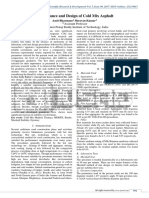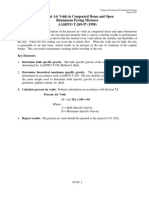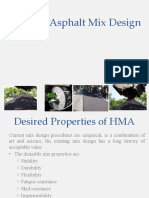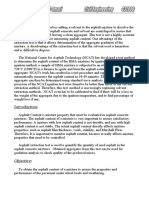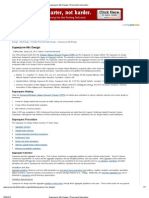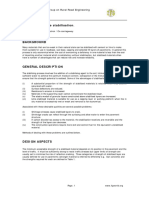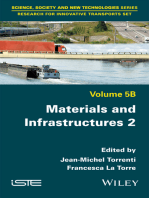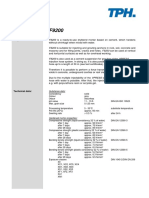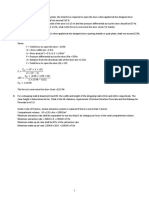Standard Test Procedures Manual: 1. Scope 1.1. Description of Test
Standard Test Procedures Manual: 1. Scope 1.1. Description of Test
Uploaded by
Muhsin KhanCopyright:
Available Formats
Standard Test Procedures Manual: 1. Scope 1.1. Description of Test
Standard Test Procedures Manual: 1. Scope 1.1. Description of Test
Uploaded by
Muhsin KhanOriginal Description:
Original Title
Copyright
Available Formats
Share this document
Did you find this document useful?
Is this content inappropriate?
Copyright:
Available Formats
Standard Test Procedures Manual: 1. Scope 1.1. Description of Test
Standard Test Procedures Manual: 1. Scope 1.1. Description of Test
Uploaded by
Muhsin KhanCopyright:
Available Formats
STP 204-10
Standard Test Procedures Manual
Section: Subject:
ASPHALT MIXES MARSHALL MIX DESIGN
1.
SCOPE 1.1. Description of Test The Marshall Method for hot-mix asphalt concrete mix design is a rational approach to selecting and proportioning two materials, asphalt cement and mineral aggregates to obtain the specified properties in the finished asphalt concrete surfacing structure. The method is intended for laboratory design of asphalt hot-mix paving mixtures. 1.2. Application of the Test The objective to be achieved using the Marshall Method for hot-mix asphalt concrete mix design is to determine an economical blend and gradation of aggregates (within the limits of project specifications) and asphalt that yields a mix having; 1. 2. Sufficient asphalt cement to ensure a durable asphalt concrete surface course. Sufficient mix stability to satisfy the demands of traffic without distortion or displacement. Sufficient voids in the total compacted mix to allow for a slight amount of additional compaction under traffic loading without flushing, bleeding and loss of stability, yet low enough to keep out harmful air and moisture. Sufficient workability to permit efficient placement of the mix without segregation. Characteristics which allow normal construction operating variations without falling outside of the specified requirements.
3.
4. 5. 1.3.
Units of Measure The units of measure will be as specified in the individual procedures that are used in the Marshall Mix Design analysis.
Date: 1993 03 22
Page 1 of 6
Standard Test Procedures Manual
Section: Subject:
STP 204-10
ASPHALT MIXES 2. APPARATUS AND MATERIALS 2.1. Equipment Required Refer to: STP 204-8 STP 204-9 STP 204-11 STP 204-15 STP 204-19 STP 204-20 STP 204-21
MARSHALL MIX DESIGN
Preparation of Marshall Compaction Specimens Theoretical Maximum Specific Gravity Marshall Stability and Flow Stripping Potential Asphalt Film Thickness Determination Hveem Stability Marshall Compaction Specimens - Density and Void Characteristics Determination Retained Marshall Stability Plasticity Index Coarse Grained Soils Sand Equivalent Specific Gravity - Bulk, Apparent Lightweight Pieces in Aggregate Percent Fractured Faces in Aggregate Clay Lumps and Friable Particles in Aggregate
STP 204-22 STP 206-4 STP 206-5 STP 206-7 STP 206-9 STP 206-14 STP 206-15 2.2.
Materials Required Refer to the Standard Test Procedures as outlined in 2.1 above.
Page: 2 of 6
Date: 1993 03 22
Standard Test Procedures Manual
Section: Subject:
STP 204-10
ASPHALT MIXES 2.3. Sample to be Tested
MARSHALL MIX DESIGN
Representative samples of all aggregate components to be used on the project and asphalt cement of the same grade and from the same manufacturer as will be used for the field work. 2.3.1. Obtaining Required Gradation For Each Aggregate Component Dry the samples of aggregate in the oven for approximately 18 hours at 105o C to 110o C. Separate aggregate into individual sieve sizes by dry sieving. Select the sieve sizes corresponding to the specifications for the "type" of Recombine individual aggregate fractions in correct proportions to obtain the average stockpile gradation which is submitted from the field along with the sample. Use a trial and error method as described in the following paragraph. Combine trial percentages of each size, then run a wet sieve and compare the result to the stockpile average. Adjust the proportions of each size and repeat the procedure until the desired gradation is achieved. Use the final percentages of each size to produce specimens as required later in the procedure. 2.4. Data Required The following data is required for each proposed aggregate gradation when preparing a Marshall Mix Design; Lightweight Pieces in Aggregate Plasticity Index of the Aggregate and Equivalent of the Aggregate Percent Fractured Faces in the Aggregate Clay Lumps and Friable Particles in Aggregate Theoretical Maximum Specific Gravity for each asphalt/aggregate combination Specific gravities for all aggregate fractions Density, air voids and voids in mineral aggregate determination for each asphalt/aggregate combination
Date: 1993 03 22
Page: 3 of 6
Standard Test Procedures Manual
Section: Subject:
STP 204-10
ASPHALT MIXES
MARSHALL MIX DESIGN
Marshall stability and flow for each asphalt/aggregate combination Stripping Potential Analysis on the recommended mix design Hveem stability on the recommended mix design Retained stability for the recommended mix design Asphalt film thickness determination for the design aggregate gradation at each asphalt content evaluated. 3. PROCEDURE 3.1. Test Procedure Prepare two or more initial trial specimens as described in STP 204-8 at an estimated optimum asphalt content. Use the combined stockpile gradation of the natural split for one set of molds. Determine the Marshall Mix Design characteristics using STP 206-7, 204-21, 204-9 and 204-11. Compare the Marshall properties for the trial molds with SHT specified properties for that aggregate type and asphalt type. If the Marshall properties for one of the chosen gradations are satisfactory, proceed with the full design procedure. If the properties are obviously outside the range, make further adjustments by changing split combinations or adding blenders/fillers. Estimate by plotting the gradation on an e.45 graph and comparing to the theoretical maximum density line (a line drawn between the origin and the point where the gradation line crosses 90% passing). Continue until the properties are satisfactory. Using the procedures previously described, prepare a series of Marshall specimens in triplicate at four asphalt contents (by weight of dry aggregate) to bracket optimum. Determine the Marshall properties for each specimen and average the results of the triplicates at each asphalt content. On a graph MR-71 or EPS-71, plot the Marshall properties (density, air voids, VMA and Marshall stability) as a function of asphalt content. Select optimum asphalt for each property; for density and stability use the peak of the curves and for VMA use the low point. For air voids, select the optimum asphalt content
Page: 4 of 6
Date: 1993 03 22
Standard Test Procedures Manual
Section: Subject:
STP 204-10
ASPHALT MIXES
MARSHALL MIX DESIGN
where air voids are 0.5 to 0.75% above the minimum specified value for that particular asphalt type. After selecting optimum asphalt from each graph average the values and use this new asphalt content for further design requirements (Stripping Potential, Hveem stability, Retained Stability, Asphalt Film Thickness). 4. RESULTS AND CALCULATIONS 4.1. Reporting Results Marshall Mix Designs shall be reported on Form MR-71 or Form EPS-71 whichever is applicable. Additional information on other options evaluated should be attached to the formal design as an Appendix. 5. ADDITIONAL INFORMATION 5.1. Asphalt Cement Content 5.1.1. Design AC Content Type 1 and Type 2 extraction corrections must be determined for the design asphalt cement content (refer to STP 204-23, Extractions and Moisture Corrections). 5.1.2. Mix Design Mix design properties are to be based on the percentage asphalt cement added. 5.2. References STP 204-8 STP 204-9 STP 204-11 STP 204-15 STP 204-19 STP 204-20 Preparation of Marshall Compaction Specimens Theoretical Maximum Specific Gravity Marshall Stability and Flow Stripping Potential Asphalt Film Thickness Determination Hveem Stability
Date: 1993 03 22
Page: 5 of 6
Standard Test Procedures Manual
Section: Subject:
STP 204-10
ASPHALT MIXES STP 204-21
MARSHALL MIX DESIGN Marshall Compaction Specimens - Density and Void Characteristics Determination Retained Marshall Stability Plasticity Index Coarse Grained Soils Sand Equivalent Specific Gravity - Bulk, Apparent Light Weight Pieces in Aggregate Percent Fractured Faces in Aggregate Clay Lumps and Friable Particles in Aggregate
STP 204-22 STP 206-4 STP 206-5 STP 206-7 STP 206-9 STP 206-14 STP 206-15
Page: 6 of 6
Date: 1993 03 22
Standard Test Procedures Manual
Section: Subject:
STP 204-10
ASPHALT MIXES APPROVAL SHEET
MARSHALL MIX DESIGN
New Revision X Date of Previous Document 92-12-10 Effective Date: 93-03-26 Description of Revision (Reason for Revision): Further discussion between the Lab Supervisors and End Product Specification Committee resulted in the agreement that mix design properties are to be based on the % asphalt added. Review/Implementation Process: Reviewed by the End Product Specification Committee and Lab Supervisors Committee. Other Manuals/Policies Affected: Nil Follow Up/Training Required: Nil
Comments/Concerns/Implications (Budget/Environment/Stakeholders):
Prepared and Recommended by D. MacLeod Quality Control Engineer Approval Recommended by R.A. Widger Date
93-03-22 Date 93-03-24
Approval Recommended by A.R. Gerbrandt Dir., Technical Standards & Policies Br. Date Approved by D.G. Metz Assistant Deputy Minister, Infrastructure
93-03-24
93-03-26 Date 93-04-29
Electronic File Updated Update Mailed - -
Date: 1993 03 22
Page: 7 of 6
You might also like
- Bitumen Emulsion NouryonDocument20 pagesBitumen Emulsion Nouryonahm21e1001No ratings yet
- ASTM 4867 (Reapproved 2014) Standard Test Method For Effect of Moisture On Asphalt Concrete Paving MixturesDocument5 pagesASTM 4867 (Reapproved 2014) Standard Test Method For Effect of Moisture On Asphalt Concrete Paving MixturesErnesto Oscar VidelaNo ratings yet
- Vasicek Short Rate Interest Rate ModelDocument5 pagesVasicek Short Rate Interest Rate Modeltheodor_munteanuNo ratings yet
- Stone Matrix Asphalt Pavement 1Document26 pagesStone Matrix Asphalt Pavement 1JAYBHAY BHAGWAT100% (1)
- Determination of Indirect Tensile (IDT) Strength of Bituminous Mixtures (ASTM D6931 - 07)Document11 pagesDetermination of Indirect Tensile (IDT) Strength of Bituminous Mixtures (ASTM D6931 - 07)zain IshaqNo ratings yet
- Uses of Crumb Rubber and Natural Rubber BitumenDocument20 pagesUses of Crumb Rubber and Natural Rubber Bitumennishankgopishetty67% (3)
- Shell Cariphalte Spray Grade PG 76: Product Specification SheetDocument1 pageShell Cariphalte Spray Grade PG 76: Product Specification SheetYogie Tb100% (1)
- Asphalt Mix Design MethodDocument12 pagesAsphalt Mix Design MethodHuda MahdiNo ratings yet
- BV Rules PtE Ch3 Sec1 AUT-UMSDocument21 pagesBV Rules PtE Ch3 Sec1 AUT-UMSJon LopezNo ratings yet
- Exp 567 Marshall Mix Design MethodDocument20 pagesExp 567 Marshall Mix Design Methodali100% (1)
- Mix Design by Marshall MethodDocument27 pagesMix Design by Marshall MethodS K Singh100% (1)
- Dense Bituminous MacadamDocument22 pagesDense Bituminous MacadamahmadsulNo ratings yet
- Performance and Design of Cold Mix AsphaDocument3 pagesPerformance and Design of Cold Mix AsphaLuis MogrovejoNo ratings yet
- Shear Susceptibility of Asphalts in Relation To Pavement PerformanceDocument27 pagesShear Susceptibility of Asphalts in Relation To Pavement PerformanceProf. Prithvi Singh Kandhal100% (1)
- Marshall Mixing & Testing - Group CDocument22 pagesMarshall Mixing & Testing - Group CnaserNo ratings yet
- Bitumen Extraction Test PDFDocument4 pagesBitumen Extraction Test PDFAyat ANo ratings yet
- Mix Design Method For Asphalt Concrete PavementDocument16 pagesMix Design Method For Asphalt Concrete PavementElumalai Srinivasan100% (1)
- Testing of Asphalt PresentationDocument52 pagesTesting of Asphalt PresentationErika Banguilan100% (1)
- SBS BinderDocument11 pagesSBS Binderprabin kumar ashishNo ratings yet
- Report On Bituminous MixDocument75 pagesReport On Bituminous MixBibhuti B. BhardwajNo ratings yet
- SUPERPLAST - High Performance Polymer-Low ResDocument37 pagesSUPERPLAST - High Performance Polymer-Low ResStanescu Axu AlexandruNo ratings yet
- Asphalt Module AASHTO T-269 2003 PDFDocument1 pageAsphalt Module AASHTO T-269 2003 PDFguru nathNo ratings yet
- Asphalt - Hot Mix Design - MarshallDocument61 pagesAsphalt - Hot Mix Design - MarshallMizanul Hoque100% (1)
- Asphalt ExtractionDocument4 pagesAsphalt ExtractionOsikur RahamanNo ratings yet
- Marshall Stability Test PDFDocument8 pagesMarshall Stability Test PDFAnonymous FO4sHLLONo ratings yet
- UserManual SuperpaveDocument19 pagesUserManual Superpavericardogr_2005100% (1)
- MC 30Document3 pagesMC 30kalina11042007No ratings yet
- Mix Design of Bitumen Stabilised Materials Best PRDocument21 pagesMix Design of Bitumen Stabilised Materials Best PRangel onofre castelanNo ratings yet
- BS 1881-5 Part 5 Methods of Testing Hardened Concrete For Other Than Strength PDFDocument15 pagesBS 1881-5 Part 5 Methods of Testing Hardened Concrete For Other Than Strength PDFjunqiangdong100% (1)
- Retained Stability-Asphalt MixDocument2 pagesRetained Stability-Asphalt Mixbinunalukandam100% (1)
- Prime CoatDocument4 pagesPrime CoatAnonymous YHcvra8Xw6No ratings yet
- Aashto M 226Document4 pagesAashto M 226Abel ClarosNo ratings yet
- Marshall Vs SuperpaveDocument72 pagesMarshall Vs SuperpaveSamarth Garg100% (1)
- Aashto T - 283Document6 pagesAashto T - 283Anonymous sSNLqweXgNo ratings yet
- AASHTO & ASTM Standard Sieve SizesDocument10 pagesAASHTO & ASTM Standard Sieve SizesdawitNo ratings yet
- Classifying Hot-Mix Recycling Agents: Standard Practice ForDocument2 pagesClassifying Hot-Mix Recycling Agents: Standard Practice ForAbdullah RafeekNo ratings yet
- Sma PavimentoDocument27 pagesSma PavimentoEdwin Garcia AredoNo ratings yet
- CSS-1 Product Data Sheet: Description and Physical PropertiesDocument1 pageCSS-1 Product Data Sheet: Description and Physical PropertiesCharith LiyanageNo ratings yet
- Technical Note Gyratory Compactor June 2012 EngDocument4 pagesTechnical Note Gyratory Compactor June 2012 Engsebastian sepulvedaNo ratings yet
- Rubberized Hot Mix Asphalt (RHMA) Mix DesignDocument32 pagesRubberized Hot Mix Asphalt (RHMA) Mix DesignAlsayed DiabNo ratings yet
- Asphalt Techno Road Engineering Ebook FrEdDocument61 pagesAsphalt Techno Road Engineering Ebook FrEdvynaNo ratings yet
- AASHTO T 85 Standard Method of Test For Specific Gravity and AbsorptionDocument11 pagesAASHTO T 85 Standard Method of Test For Specific Gravity and AbsorptionMuhammad Rizaldi Nuraulia100% (1)
- European Standards For AsphaltsDocument7 pagesEuropean Standards For AsphaltsAlban Tabaku100% (2)
- Correction For Coarse Particle in The Soil Compaction Test AASHTO T-224 (1996) (Modified)Document2 pagesCorrection For Coarse Particle in The Soil Compaction Test AASHTO T-224 (1996) (Modified)Julio César ChávezNo ratings yet
- prEN 12697-33 CompacteurDocument18 pagesprEN 12697-33 CompacteurDamouh Mohamed100% (1)
- Superpave Mix Design - Pavement InteractiveDocument7 pagesSuperpave Mix Design - Pavement InteractiveHoracio Reyes de la Rosa100% (1)
- Standard Specification For Crack Filler, Hot-Applied, For Asphalt Concrete and Portland Cement Concrete PavementsDocument3 pagesStandard Specification For Crack Filler, Hot-Applied, For Asphalt Concrete and Portland Cement Concrete PavementsJORGE ARMANDO CASTRO ESCUDERONo ratings yet
- Preparation of Asphalt Mixture Specimens Using Marshall ApparatusDocument8 pagesPreparation of Asphalt Mixture Specimens Using Marshall Apparatussumukh swaroopNo ratings yet
- AASHTO M 323-13 Superpave Volumetric Mix DesignDocument13 pagesAASHTO M 323-13 Superpave Volumetric Mix DesignMir Shahnewaz Arefin100% (2)
- Marshall ReportDocument12 pagesMarshall ReportZulfadhli Zullkeply100% (1)
- M 17-07 Filler For Bituminous Paving Mix PDFDocument3 pagesM 17-07 Filler For Bituminous Paving Mix PDFWalticoZegarraHerrera100% (1)
- Concrete Mix Design and Casting of Sample For Different TestDocument4 pagesConcrete Mix Design and Casting of Sample For Different TestAqeel AliNo ratings yet
- Cement and Lime StabilisationDocument11 pagesCement and Lime Stabilisationprmrao100% (1)
- جميع اختبارات الاسفلتDocument41 pagesجميع اختبارات الاسفلتحسين الشهريNo ratings yet
- Utilization of Copper Slag in Bituminous MixDocument12 pagesUtilization of Copper Slag in Bituminous MixMuktipada DasNo ratings yet
- Lec 15 Highway Engineering - Asphalt Paving MixturesDocument20 pagesLec 15 Highway Engineering - Asphalt Paving MixturesDr Firas Asad100% (2)
- MTO - OPSS1151 Nov04Document19 pagesMTO - OPSS1151 Nov04Jassy YEANo ratings yet
- Asphalt Concrete Mix DesignDocument14 pagesAsphalt Concrete Mix DesignLuffy MonkeyNo ratings yet
- Department of Civil and Environmental Engineering, School of Engineering Cedat, Makerere UniversityDocument50 pagesDepartment of Civil and Environmental Engineering, School of Engineering Cedat, Makerere UniversityBAMSNo ratings yet
- Standard Specifications For Transportation Materials and Methods of Sampling and Testing - Print WindowDocument13 pagesStandard Specifications For Transportation Materials and Methods of Sampling and Testing - Print WindowrajibchattarajNo ratings yet
- Mastic Asphalt Wearing Course SurfacingDocument18 pagesMastic Asphalt Wearing Course SurfacingSoumitra SengarNo ratings yet
- Properties:: F9200 Is A Ready-To-Use Dryblend Mortar Based On Cement, Which HardensDocument3 pagesProperties:: F9200 Is A Ready-To-Use Dryblend Mortar Based On Cement, Which HardensMuhsin KhanNo ratings yet
- Ecocryl: CE-marking in Accordance With EN 1504-5Document4 pagesEcocryl: CE-marking in Accordance With EN 1504-5Muhsin KhanNo ratings yet
- From Teacher To ManagerDocument6 pagesFrom Teacher To ManagerMuhsin KhanNo ratings yet
- From Teacher To Manager - 1Document11 pagesFrom Teacher To Manager - 1Muhsin Khan100% (1)
- RTA Spare Duct FormateDocument1 pageRTA Spare Duct FormateMuhsin KhanNo ratings yet
- Community Service Form 2018 / 2017: Applicant InformationDocument1 pageCommunity Service Form 2018 / 2017: Applicant InformationMuhsin KhanNo ratings yet
- Asphalt Professional ASPRO - 71 PDFDocument40 pagesAsphalt Professional ASPRO - 71 PDFMuhsin KhanNo ratings yet
- Factors Influencing English Language Training CentDocument10 pagesFactors Influencing English Language Training Centb20fa1908No ratings yet
- ProjectDocument22 pagesProjectsingh.suraj885150No ratings yet
- ELEC 4601 NotesDocument23 pagesELEC 4601 NoteskolagdeshpandeNo ratings yet
- Geovariances Geostats For Mining Engineers and Geologists-3Document2 pagesGeovariances Geostats For Mining Engineers and Geologists-3Odair_KanelaNo ratings yet
- 2222need For An Anterior Point of Reference in Face Bow Transfer The Changing Viewpoint Changing Concepts Regarding Anterior Reference PointDocument3 pages2222need For An Anterior Point of Reference in Face Bow Transfer The Changing Viewpoint Changing Concepts Regarding Anterior Reference PointDr. Zardasht N. BradostyNo ratings yet
- Class 5 Test-PaperDocument6 pagesClass 5 Test-PaperAnwesha Satpathy100% (1)
- Me-311 Transport Phenomenon Unit I Introduction and ConductionDocument5 pagesMe-311 Transport Phenomenon Unit I Introduction and Conductionmrigank2014No ratings yet
- Wireless Digital Stethoscope Using Bluetooth TechnDocument10 pagesWireless Digital Stethoscope Using Bluetooth TechnHitesh DammuNo ratings yet
- Fluid - Is A Substance That ContinuallyDocument8 pagesFluid - Is A Substance That ContinuallybenjerickNo ratings yet
- Auto 2 UNIT 4Document8 pagesAuto 2 UNIT 4Pearly SapalledaNo ratings yet
- Installation of Roof & Wall Panels (Type KRIP/KWIP)Document2 pagesInstallation of Roof & Wall Panels (Type KRIP/KWIP)NitinNo ratings yet
- 160.102 Algebra (Auckland, Manawat U, and Distance) Assignment 2. Due 11pm Tuesday 26 MayDocument2 pages160.102 Algebra (Auckland, Manawat U, and Distance) Assignment 2. Due 11pm Tuesday 26 MayAiman qayyumNo ratings yet
- Parker Su SeperatörüDocument2 pagesParker Su SeperatörümuratgeldeyatNo ratings yet
- Troubleshooting Guide HarmonyDocument3 pagesTroubleshooting Guide HarmonyAndrea IbarraNo ratings yet
- Carrier Packaged Product DataDocument32 pagesCarrier Packaged Product Datakingbentot100% (2)
- Xone - (Company Address)Document6 pagesXone - (Company Address)bilalNo ratings yet
- Bolt Torquing Tensioning Procedure PDFDocument29 pagesBolt Torquing Tensioning Procedure PDFric leonisoNo ratings yet
- 2020 Jakubas Haloantimonates HalobismuthatesDocument22 pages2020 Jakubas Haloantimonates HalobismuthatesNacho Delgado FerreiroNo ratings yet
- Jordan Intellijet MACC 2005 PDFDocument41 pagesJordan Intellijet MACC 2005 PDFaminNo ratings yet
- Standard Parts User GuideDocument93 pagesStandard Parts User Guidegad30No ratings yet
- Effect of Current On EDMDocument58 pagesEffect of Current On EDMAli M. ElghawailNo ratings yet
- Providing Gage Solutions Since 1912Document154 pagesProviding Gage Solutions Since 1912qcomoNo ratings yet
- Passive Islanding Detection Methods by Using DQ PLL: Kothapalli Rajesh Kumar, Kotari Venkatesh, Gubbala Ram PrasadDocument4 pagesPassive Islanding Detection Methods by Using DQ PLL: Kothapalli Rajesh Kumar, Kotari Venkatesh, Gubbala Ram PrasadJiakeat LiauNo ratings yet
- 3G TerminologyDocument17 pages3G TerminologyArio NugrohoNo ratings yet
- Arieletal ExperimentalDesigns 2021Document239 pagesArieletal ExperimentalDesigns 2021Samuel Temitope, OGUNYAKINNo ratings yet
- Fundamental of Air ConditioningDocument46 pagesFundamental of Air ConditioningOlay KwongNo ratings yet
- Underpotential Deposition of Lead On Single Crystal FacesDocument14 pagesUnderpotential Deposition of Lead On Single Crystal FacesAzucena osornio villaNo ratings yet












